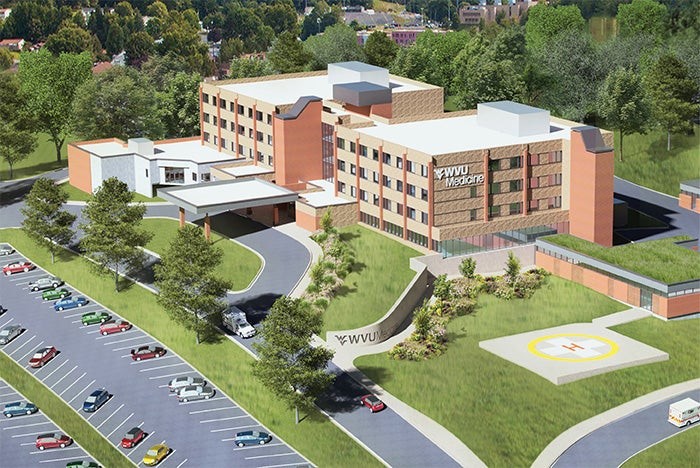Rural hospitals prepare physical environments for safe reopenings

An artist’s rendering shows the West Virginia University Health System’s vision for a future expanded and upgraded Fairmont Medical Center.
Image courtesy of WVU Medicine
The focus on keeping rural hospitals operating has turned into action with the Centers for Medicare & Medicaid Services’ new rural emergency hospitals designation. Yet, as health care systems that have reopened once-closed hospitals already recognize, rural hospitals hovering on the brink of closure require funding to do more than simply keeping the lights on.
This was the lesson WVU Medicine, part of the West Virginia University Health System, learned in its rapid race to reopen rural hospital Fairmont Medical Center in 2020 in Fairmont, W. Va. Former owner Alecto Healthcare Services closed the facility in March 2020, leaving a gap in care for rural Marion County. When the facility reopened under WVU Medicine three months later, it was evident that maintenance had been deferred.
“When we came in, a lot of things had to be torn apart and reconditioned and made operable,” says Aaron Yanuzo, chief operating officer at Fairmont Medical Center.
While the need for renovations was clear, the priority was a speedy reopening. As a result, regulatory requirements shaped the direction of initial upkeep. During the month between purchasing the facility and reopening, the operations team focused on “patch and paint” work for two of the hospital’s four floors.
Keeping down costs was critical, Yanuzo explains, as the reopened hospital was limited in what services it could bill for several months while working on achieving accreditation. While closed, the hospital was surveyed by state authorities to allow for building occupancy. Once reopened, Fairmont saw patients at its own cost before it could request a Joint Commission accreditation survey, which took place in fall 2020.
Patchwork may have gotten the doors opened, but those initial assessments indicated that boilers and HVAC units had fallen into disrepair due to a lack of maintenance in the time leading up to Fairmont’s closure. “We learned that we needed to build an entirely new central energy plant for the building in order to sustain today’s technology, power and heating needs,” Yanuzo says.
Other maintenance needs became evident through day-to-day operations. Dated windows were drafty and leaked. Aged pipes made flooded offices a regular occurrence. As these items are repaired, they also inform the hospital’s 10-year plan. The plan accounts for an eventual $110 million renovation.
For facilities that have sat closed for much longer, the list of needs becomes longer, too. Lee County Community Hospital in Pennington Gap, Va., was closed for six years before Ballad Health began negotiations with the Lee County Hospital Authority around reopening.
In health care, where equipment can become dated within months, the facilities team recognized that adapting an older building to meet a new model of care delivery would prove challenging compared to building a new facility. Yet discussions with the community made it clear that the existing building was an important fixture within rural Lee County and its population of just under 22,000.
Like Fairmont, Lee County was also driven by a rapid reopening. Unfortunately, workforce issues exacerbated by the COVID-19 pandemic made it difficult to move forward in pace with expectations.
“Lee County Community Hospital’s rural nature presented a challenge with contractors,” says Nick Robinette, corporate director of construction and project management at Ballad Health. “Qualified subcontractors would need to commute a minimum of 90 minutes each way, and many candidates were not able to commit to the travel time.”
Ultimately, the team confined initial services to the first floor of the four-story facility. The hospital worked with the Lee County Hospital Authority to develop and refine the list of services to prioritize and manage community expectations.
“Health care, especially rural health care, has changed drastically during the last two decades,” says Mitch Kennedy, assistant vice president and administrator at Lee County Community Hospital. “Instead of reopening Lee County Community Hospital with an intensive care unit and surgical department, we focused on the low-acuity, high-need services that could help patients receive the care they need close to home. To keep the hospital viable, we had to give up the higher-level service that had once been available; though, through the wider Ballad Health system of care, we can provide seamless access to those services.”
That said, as a critical access hospital, Lee County is subject to a higher level of reimbursement. This “enables us to reinvest in additional services such as geropsychology, wound care and other opportunities to keep patients close to home,” Kennedy says.
Both Fairmont and Lee County emphasize that precisely defining services is important to opening, but all needs identified should feed into a 10-year master plan.
“The work to open the facility should go hand-in-hand with future expansion,” Robinette says.




